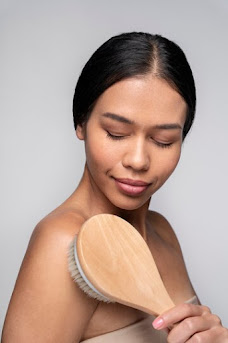Wellness Wows (Dry Brushing)
Dry Brushing: The Trending
Grooming Routine
BY PRAMITA BOSE
Dry brushing is a grooming culture
that has a historical legacy. The hygienic routine helps purge the skin of dry,
dead cells from its topmost layer by sweeping the body squeaky clean with a
tolerably soft bristle brush.
Support for Bodily Functions
Some advocate
abdominal dry brushing to arouse the nerves linked to digestion, thus spurring
gut motility. While dry brushing can’t be a permanent solution to eliminate
cellulite (fat deposition in thighs, stomach and hips making the skin look
lumpy and dimpled), it can smoothen the skin for the moment by redistributing body
fluids and bettering blood circulation to lend a firmer, toned exterior.
Incidentally, dry brushing helps stimulate
the nervous system and lend the skin with that lustrous radiance. “It
stimulates the skin’s nerve endings, providing a rejuvenating sensation akin to
gentle massages. The increased blood flow to the skin nourishes cells,
resulting in a shiny, healthy complexion,” reports Dr. Mahnaz Jahaan, an aesthetic expert,
cosmetologist and the founder of Keraderm Clinic.
Method to Dry Brush
There is a proper way to dry brush in terms of rendering correct brushstrokes, using the brush across the whole body or only specific parts of the body, and the direction from where to begin and at which point to end the process.
One of the major
reasons why people do dry brushing is to drain out all the toxins and the dull,
dead cells from the body. For example, we exfoliate our face twice a week. This
method not only relaxes the skin and makes it bouncier and more pliable but
also generates a fresh feeling.
“Body brushing is best done before taking a bath.
Make sure your skin is completely dry before initiating the regime. Start from
your feet and move upwards to the groin region and then towards your armpits followed
with the neck area. Remember you have to cleanse the lymph nodes. Brush your
skin using a wide, circular or clockwise motion. Use less pressure in the areas
where your skin is thin and light and press harder on the thicker zones like
the soles of your feet,” teaches Dr. Blossom Kochhar,
beauty expert and pioneer in aromatherapy.
Strict No-No for Kids & Seniors
Should children and aged people be dissuaded from dry
brushing because of the kids' sensitive skin and the dry, weathered skin of the
seniors, which might be subject to injury and inflammation?
“Yes, minors and old adults should avert dry brushing due
to possible risks. Aged persons often have thinner and feebler skin that is
more prone to inflammation while children have delicate skin that can easily get
affected by scrapes and scratches. Using a stiff-bristled brush on the skin
might result in microabrasions, irritation or worsen the pre-existing skin
conditions like eczema or dryness in certain age groups. So it’s always safer
to use gentle alternatives, such as mild cleansers and moisturising routines,”
enlightens dermatologist Dr.
Nirupama Parwanda, also the founder of Zolie Skin Clinic.
Lack of Scientific Evidence
“See, the human body’s detox processes are primarily
handled by its vital organs like the liver and a pair of kidneys. Dry brushing in
that context doesn’t considerably influence the internal physiological functions.
However, it can provide a restorative and energising experience, which some
people find immensely beneficial,” avers Dr. Meghna Mour, chief dermatologist at Skuccii
Supercliniq.
******
Ideal Brush Application
Different kinds of brushes are suitable for varied skin types. “Choosing the right brush according to skin type ensures a more gainful and safer experience. Always test on a small area of your skin surface first and follow it up with a proper moisturising care,” advises Dr. Mour.
Some of the brushes matching the skin types are as follows:
●
For Sensitive or Dry Skin: Soft-bristled brushes made from natural fibres
like goat hair or ultra-soft synthetic bristles are suitable.
●
For Normal or Oily Skin: Medium-firm bristles, such as those made from
natural boar bristles, offer effective exfoliation without causing damage.
● For Thicker or
Rougher Skin (e.g., feet and elbows): Firmer brushes like those with cactus
or sisal bristles can help remove dead skin more effectively.
*********************************************************************************






Comments
Post a Comment